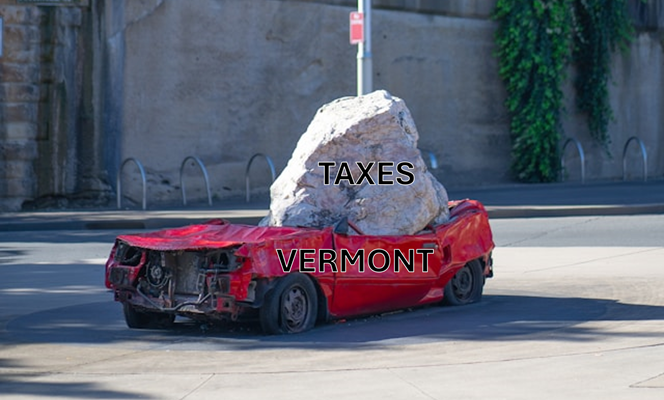In 2024, the Vermont legislature charged the State Treasurer’s Office with studying what a “Cap & Invest” program would look like as a means for meeting the Global Warming Solutions Act (GWSA) targets for greenhouse gas reduction in the transportation sector (aka you driving your car). That report is now complete, and, just as the Public Utilities Commission concluded in regard to the Clean Heat Standard for the thermal sector (aka you heating your home), Cap & Invest gets an arms-waving, eyes-bulging, voice-shrieking, “DON’T DO IT!!!”
Deputy Treasurer Gavin Boyles testified before the House Energy & Digital Infrastructure Committee that they ran several scenarios for a Vermont Cap & Invest program, which would force fossil fuel dealers to buy credits at auction to sell their products, the cost of which would be passed along to the consumer. Boyles reported that there is no scenario in which Vermont will meet our 2030 greenhouse gas reduction targets mandated under the GWSA, and the only way to meet the 2050 targets is with what he called the “high price scenario.” The report text describes it as “full sectoral coverage, full reinvestment, high price.”
This high price scenario would mean Vermont joining the Western Climate Initiative (WCI) with California and Quebec – the only existing option — with a tax/fee/surcharge rising to 69¢ per gallon on gasoline and 83¢ for diesel and home heating fuel by 2030 (WCI is an economy-wide program also covering home heating fuels), and that would steadily rise at a rate of 5 percent plus inflation up to 80¢ per gallon of gasoline and higher for diesel and home heating fuels.

So that’s what high price means. What does “full reinvestment” mean? All the money collected from this fuel tax must be spent on greenhouse gas reduction measures. No money collected can be redistributed to lower-income Vermonters as a safety net to mitigate the cost impacts of the program. In other words, the GWSA screws poor, rural Vermonters. Hard. Especially and royally.
To illustrate just how royally, the report creates three fictional households, upper, middle, and lower income, based on state average incomes, fuel use, miles driven, etc. For the low-income Sawyer family, living in Essex County, in older housing stock, and having to commute long distances on dirt roads to work each day,
The added [motor] fuel cost at the initial, lowest WCI price ($0.26/gallon) for the Sawyer family would be about $1,000.… The Sawyers’ home heating costs would go up by about 10% under WCI – about $300 per year. They have no room in their budget to absorb any increased costs month-to-month.
Now these numbers are based on what the WCI charge is today in 2025, 26¢ per gallon, not the 2030 projection of 69¢/83¢ for gas and heating fuel respectively. Apply that tax rate, and the gasoline cost increase alone jumps to over $2700 per year.
Meanwhile, the fictitious upper-income Sparks family living in Montpelier and earning $200,000 per year working for a national non-profit (VPIRG? Conservation Law Foundation? Sounds about right.) and from home, while receiving subsidies for their electric vehicles and heating systems paid for by people like the Sparks, see virtually zero cost impact from the Cap & Invest taxes/fees.
This, folks, is why we refer to Vermont’s “climate” policies as simply “wealthfare”. The rural poor pay for the high-end toys of the urban rich.
And, while lower-income Vermonters get hit the hardest, all of us are going to feel the negative impacts of a Cap & Invest regime to some extent. As the report notes:
The economic impact of raising fuel prices is broadly negative, and that effect is unpredictable. Raising fuel prices – which WCI would do – inexorably causes other costs to rise, as it costs more to transport goods, to heat commercial and industrial spaces, to manufacture goods, and the list could go on…. Given these economic conditions – combined with rising healthcare costs and increased property taxes – it is a very difficult time to impose the sudden costs on Vermonters that would result from joining the WCI.
Given these realities, some on the Left-hand side of the aisle, such as Treasurer Mike Pieciak, have suggested implementing a smaller scale, less costly version of Cap & Invest program at a later date that includes a safety net program for low income Vermonters. The problem with that suggestion is that the Global Warming Solutions Act makes it illegal.
The greenhouse gas reduction dates and targets in the GWSA are legally binding mandates. The law requires that Vermonters reduce our greenhouse gas emissions 40% below 1990 levels by 2030 and 80% by 2050. If we don’t do this, the GWSA gives standing to any person or organization to sue the state at taxpayers’ expense, costing us wasted millions of dollars. This is already happening with the Conservation Law Foundation suing in regard to the already missed 2025 GWSA target.
The only logical, compassionate policy response given the cost of these programs, their undeniably regressivity, and the logistical impossibility of achieving the mandated targets is to repeal the Global Warming Solutions Act, or at the very least remove the unrealistic mandates as well as that idiotic, irresponsible, and wasteful lawsuit provision.
Governor Scott has put forward a proposal to do exactly this in H.289, which is now before the House Energy & Digital Infrastructure Committee. However, Rep. Laura Sibilia (I-Dover), ranking member of that committee, stated in a recent interview with the Vermont Natural Resources Council (aka The Sparks clan), doubled down saying, “The Global Warming Solutions Act is foundational to Vermont’s climate work.” And the governor’s proposed reforms of the law, “are not things we can consider…. Those issues are no-gos.” In other words, screw you, Sawyer family, and everybody who looks like you.
